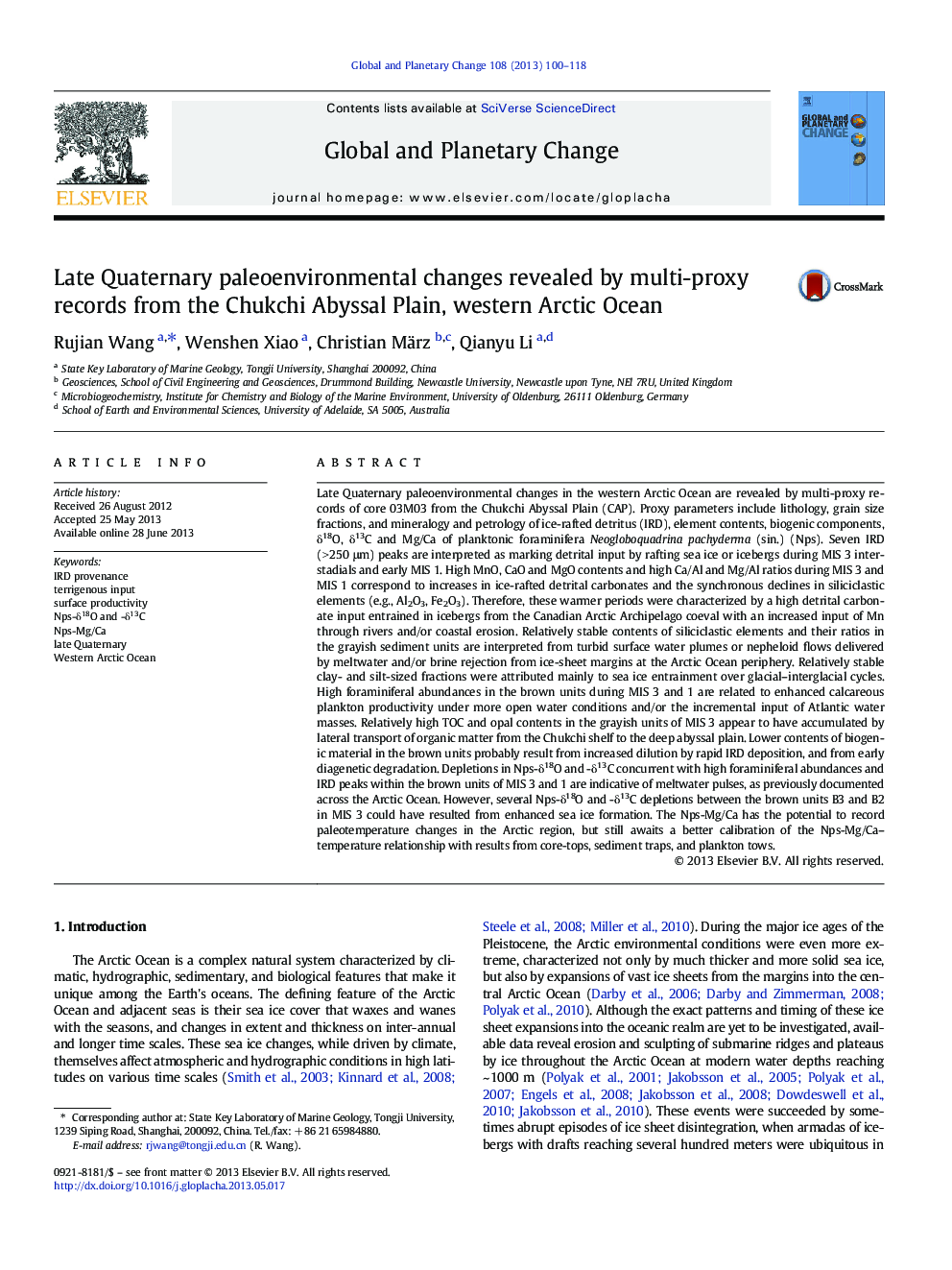| کد مقاله | کد نشریه | سال انتشار | مقاله انگلیسی | نسخه تمام متن |
|---|---|---|---|---|
| 6348259 | 1621673 | 2013 | 19 صفحه PDF | دانلود رایگان |
عنوان انگلیسی مقاله ISI
Late Quaternary paleoenvironmental changes revealed by multi-proxy records from the Chukchi Abyssal Plain, western Arctic Ocean
دانلود مقاله + سفارش ترجمه
دانلود مقاله ISI انگلیسی
رایگان برای ایرانیان
کلمات کلیدی
موضوعات مرتبط
مهندسی و علوم پایه
علوم زمین و سیارات
فرآیندهای سطح زمین
پیش نمایش صفحه اول مقاله

چکیده انگلیسی
Late Quaternary paleoenvironmental changes in the western Arctic Ocean are revealed by multi-proxy records of core 03M03 from the Chukchi Abyssal Plain (CAP). Proxy parameters include lithology, grain size fractions, and mineralogy and petrology of ice-rafted detritus (IRD), element contents, biogenic components, δ18O, δ13C and Mg/Ca of planktonic foraminifera Neogloboquadrina pachyderma (sin.) (Nps). Seven IRD (> 250 μm) peaks are interpreted as marking detrital input by rafting sea ice or icebergs during MIS 3 interstadials and early MIS 1. High MnO, CaO and MgO contents and high Ca/Al and Mg/Al ratios during MIS 3 and MIS 1 correspond to increases in ice-rafted detrital carbonates and the synchronous declines in siliciclastic elements (e.g., Al2O3, Fe2O3). Therefore, these warmer periods were characterized by a high detrital carbonate input entrained in icebergs from the Canadian Arctic Archipelago coeval with an increased input of Mn through rivers and/or coastal erosion. Relatively stable contents of siliciclastic elements and their ratios in the grayish sediment units are interpreted from turbid surface water plumes or nepheloid flows delivered by meltwater and/or brine rejection from ice-sheet margins at the Arctic Ocean periphery. Relatively stable clay- and silt-sized fractions were attributed mainly to sea ice entrainment over glacial-interglacial cycles. High foraminiferal abundances in the brown units during MIS 3 and 1 are related to enhanced calcareous plankton productivity under more open water conditions and/or the incremental input of Atlantic water masses. Relatively high TOC and opal contents in the grayish units of MIS 3 appear to have accumulated by lateral transport of organic matter from the Chukchi shelf to the deep abyssal plain. Lower contents of biogenic material in the brown units probably result from increased dilution by rapid IRD deposition, and from early diagenetic degradation. Depletions in Nps-δ18O and -δ13C concurrent with high foraminiferal abundances and IRD peaks within the brown units of MIS 3 and 1 are indicative of meltwater pulses, as previously documented across the Arctic Ocean. However, several Nps-δ18O and -δ13C depletions between the brown units B3 and B2 in MIS 3 could have resulted from enhanced sea ice formation. The Nps-Mg/Ca has the potential to record paleotemperature changes in the Arctic region, but still awaits a better calibration of the Nps-Mg/Ca-temperature relationship with results from core-tops, sediment traps, and plankton tows.
ناشر
Database: Elsevier - ScienceDirect (ساینس دایرکت)
Journal: Global and Planetary Change - Volume 108, September 2013, Pages 100-118
Journal: Global and Planetary Change - Volume 108, September 2013, Pages 100-118
نویسندگان
Rujian Wang, Wenshen Xiao, Christian März, Qianyu Li,